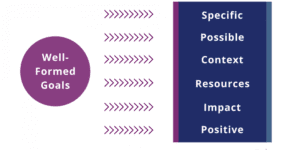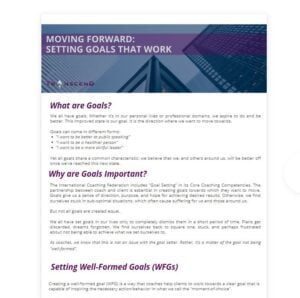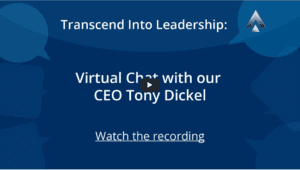WHAT ARE GOALS?
We all have goals. Whether it’s in our personal lives or professional domains, we aspire to do and be better. This improved state is our goal. It is the direction where we want to move towards.
Goals can come in different forms:
- “I want to be better at public speaking”
- “I want to be a healthier person”
- “I want to be a more skillful leader”
Yet all goals share a common characteristic: we believe that we, and others around us, will be better off once we’ve reached this new state.
WHY ARE GOALS IMPORTANT?
The International Coaching Federation includes “Goal Setting” in its Core Coaching Competencies. The partnership between coach and client is essential in creating goals towards which they want to move. Goals give us a sense of direction, purpose, and hope for achieving desired results. Otherwise, we find ourselves stuck in sub-optimal situations, which often cause suffering for us and those around us.
But not all goals are created equal.
We all have set goals in our lives only to completely dismiss them in a short period of time. Plans get discarded, dreams forgotten. We find ourselves back to square one, stuck, and perhaps frustrated about not being able to achieve what we set ourselves to.
As coaches, we know that this is not an issue with the goal setter. Rather, it’s a matter of the goal not being “well-formed”.
SETTING WELL-FORMED GOALS (WFGS)
Creating a well-formed goal (WFG) is a way that coaches help clients to work towards a clear goal that is capable of inspiring the necessary action/behavior in what we call the “moment-of-choice”.
Coaches ensure that a goal has the following components:

A WFG has tremendous generative power, and the work necessary to create it can often lead easily and quickly to behaviors and actions necessary. Such a goal, its benefits (impacts), steps and necessary resources are easily brought back to mind to inspire action in the “moment-of-choice”. It is oriented to positive action and change rather than encouraging attention to problems and behaviors which lead to being stuck.
Below is an overview of the characteristics of WFGs and some questions you can start asking yourself, your clients, and your people to gain more clarity and motivation on your goals.
SPECIFIC
The core of the WFG process is to elicit specificity as far as possible. Check that the goal has enough specificity that it can be remembered easily in the “moment-of-choice”.
Goals that are not specific enough:
“I want to be happier”,
“I want to be less emotional around others”
An example of a specific goal:
“I want to learn to allow others, where appropriate, to fully express themselves without interruption as part of becoming a more empowering leader”.
3 QUESTIONS TO ASK:
- What is your goal, specifically?
- How will you know when you have it or when you have made progress on the journey?
- Or, what will be the immediate evidence of reaching your goal (a tangible proof, a feeling, an outcome, or a measurable behavioral change or strengthened competency)?
POSSIBLE
A WFG is something that a person can actively do something about. This may simply be a matter of skillful phrasing of the goal.
Out of our control:
“I want my direct reports to support me better” – this goal focuses on a desired outcome.
Under our control:
“I want to find ways to better coach, train and support my direct reports so that they are in a position to take on more responsibility” – this goal focuses on what they can do to make the result probable.
3 QUESTIONS TO ASK:
- What needs to happen so that that might happen? (Keep asking the question until you get to a first step the client can take)
- What might you need to do differently so that might happen?
- What might be your role in this?
CONTEXT
Meaning is usually defined by context. In broad terms, this is the “when”, “where”, “how” and “with whom” of the goal.
The coach invites the client to explore the various contexts that surround their goal. This makes the goal even more specific and motivational as the image of attainment becomes better anchored. This helps create an emotionally charged visual/memory which “sinks” into the mind, making it meaningful and more accessible in those key “moments-of-choice”.
Example:
“I would particularly like to be more patient with my staff when I feel frustrated because they have delivered poor results on important projects”.
3 QUESTIONS TO ASK:
- In what situations/circumstances is this relevant (this question may elicit an answer which covers all or most of the relevant contexts – time, people, places and even emotions)
- To what part of your life would you like this change to apply?
- With whom does this apply?
RESOURCES
This is a quick reality check on the various resources available which will enable achievement of the goal. Do a quick check early on to ensure you or the person you are coaching have the skills, knowledge, time, mindsets, relationships and other internal and external resources that support the achievement of the goal.
3 QUESTIONS TO ASK:
- What values/beliefs do you hold which can support you? (Or might get in the way, and how can you work with this?)
- What other mindsets can support you? (Or interfere, and how can you work with this?)
- What skills/strengths/knowledge/experience that you have which can support? (Or what needs to be developed?)
IMPACT
This area is where you enquire about the consequences of the goal in other areas of their life or the lives of others.
A simple example might be the impact on family of a new job that requires travel or significant amounts of late work. Another example might be how something you need to do at work may impact on their beliefs or values.
The idea is to have all parts of the person agree with the goal, with congruence between desires, values, and needs and an understanding of what might get in the way.
3 QUESTIONS TO ASK:
- On a scale of 1-10, how important is this to you?
- How will making this change alter your experience of life?
- What else will you gain? What might you lose?
POSITIVE
A positively stated goal can provide a beacon on which we can calibrate our behavioural compass. Such goals are also conducive to positive, resourceful, creative and collaborative mindsets (known as “reward states”).
Negatively stated goals (goals articulated as “problems to get rid of”) tend to encourage what is known as a “threat state” mindset. Such a state of mind inhibits creativity, collaboration and resourcefulness.
3 QUESTIONS TO ASK:
- Check goal is stated in positive terms – something wanted rather than something not wanted. “Moving towards something” rather than “moving away” from something.
- How might you state that in positive terms? (if the goal is stated negatively)
- What is it you do want (or want instead)? (if the goal is about not wanting something)
FINAL QUESTIONS – WHERE THE RUBBER MEETS THE ROAD
In the process and questions above, the client may realize that they are not prepared to give up that which is preventing them from making the changes they need to get what they want. Challenge the client by asking:
And given what you have told me, what changes would you like to make to your goal?
The WFG often changes goals and the way we state them. Make sure that either the old goal or the newly formed and refined goal fits the characteristics of a WFG.
Moving forward, some final questions can include:
3 QUESTIONS TO ASK:
- What is it that you would like to remember in future “moments-of- choice with regards to achieving this goal?
- How might you remember this?
- If you could remember this in all key moments, would you make the necessary choices that lead to action in the direction of your goals?
The 3 questions often point towards new goals, for example the cultivation of mental qualities or values such as patience, presence, curiosity, acceptance, and so forth. If this happens, partner with the client to make these goals well-formed using the process above.
WANT TO LEARN MORE ABOUT SETTING WELL-FORMED GOALS?
Related Posts
Thriving in Remote Work: Boost Your Team’s Productivity and Well-being

In today’s remote work culture, it’s crucial to prioritise employee…







Comments are closed.